Benjamin John Benton
Benjamin John Benton, born in Essex England, brought his family to Australia aboard the "Elizabeth", arriving in the Mornington area in about 1851.
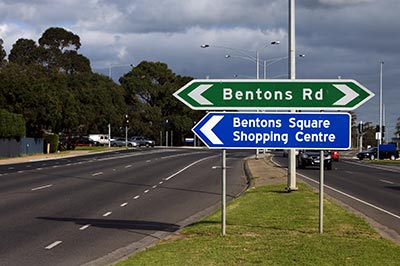
Benjamin was a man of many skills. He farmed the land, and worked with James Firth making roads in the area.
He took the first sub-contract to supply pylons for the Mornington Pier, and he camped out at the Jean Jean (Moorooduc) forest while getting the timber for that.
His team of bullocks also carted wood to the pier to be shipped to Melbourne to fuel the bakers’ ovens.
After a public meeting was held at the Tanti Hotel in 1854, a submission was sent to the Ports and Harbour Commission for the building of a pier and breakwater at Mornington.
The design included a 116 foot rock embankment to protect the pier from storms and possibly two breakwaters, one east and one west.
The pier and breakwaters were completed in 1857 with further additions to the pier completed in 1861.
A total of nearly £9000 was spent on building and extending the pier.
Ben had a team of bullocks and was engaged in supplying wood for Melbourne.
He was one of the trustees responsible for the acquisition of ½ acre of land in Moorooduc on which to build the first school and church.
He died in 1914 and was buried at Mornington Cemetery.
Click here for some Ben Benton memories
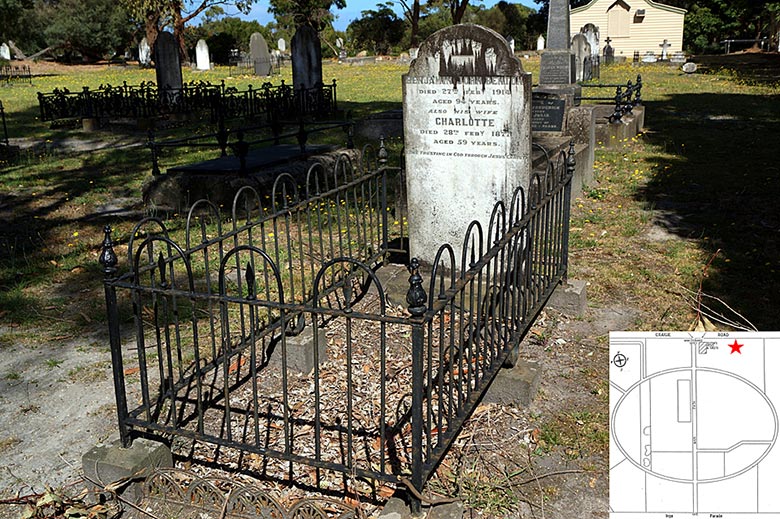
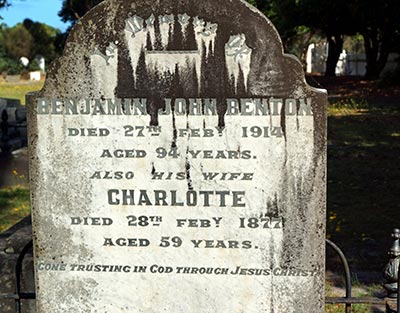
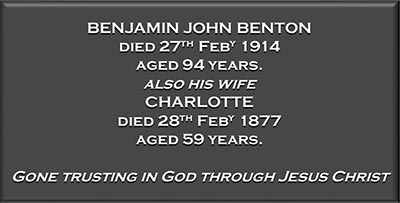
As early as the 1860s, the people of Moorooduc identified themselves as a community in their own right, and they decided to construct a timber church and school on Moorooduc Road, near the corner of the Tyabb Road.
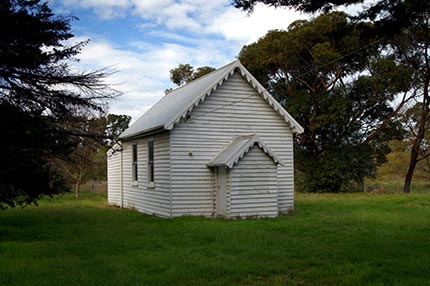
In 1862, Mrs. Balcombe, James Grice and James Butchart mounted a public appeal to raise the funds.
On May 10, 1863, Benjamin Benton, John Sykes, John Stone, Thomas Allchin, James Flood and James McLellan as trustees, purchased half an acre as a school site from Alexander McKay.
At that time, there existed an agreement between the Presbyterians and the Church of England that where people were few, facilities would be shared. So although the church began life as a Church of England, during the 1890s Presbyterian services were conducted there by the Reverend James Caldwell of Mornington.
In 1916 the land and building were transferred to the Congregational Union of Victoria. The building also functioned as Moorooduc's first school, from the early 1860s until 1880.

Benjamin John Benton was married three
times and he died in 1914 with
120 living descendants!

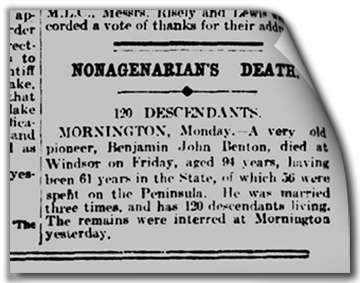
Death Notice from:
The Argus, 3 March, 1914
In the book "The Men Who Blazed the Track" is an account of the Arbor Day function held at Balnarring involving a group of pioneers, on Saturday 5th July 1913. There were 150 people present. This is Ben Benton’s account:
My first introduction to the Peninsula was to go to Dromana with Felix Foster to cart sleepers from the mountain at Arthur’s Seat for the Geelong railway, about the year 1857, with bullock teams – good old bullocks, they were. If there is an afterlife for them, I hope it will be where there is plenty of grass and water. They have played their part in opening up the wild bush as well as the pioneers who drove them. At that time there was no township of Mordialloc. We had to go out in the sea to get around the mouth of the creek, till the water was up to the floor of the drays.
The creek waters run deep out in the bay. The same applies to Kananook Creek. Mr O’Donnell was the owner of the run from Mordialloc to Frankston, taking in the Carrum Swamp. He lived near the Mordialloc beach. His neighbours in those days were the blacks. He used to supply them with blankets, and I think with oatmeal.
There were no roads on the Peninsula, and we had to wade our way through the ti-tree up half way to the bullocks’ knees, stopped now and then for a big snake lying across the track. The first night we camped at Captain Baxter’s. It was there I saw the first short-horned cattle. He got the bull about 1837. The animal arrived here with a regiment from India. Then there was John Barker, Capt Schanck, and the Tucks. One of the earliest white men, who came over with Bateman (sic) as a surveyor, was Mr Wedge. He took up a run near Lyndhurst, and kept a grey imported stallion. Lanark, had the best stock that had been bred in the country. It grew some big bullocks up to a thousand pounds weight.
It also raised a few good men. Take your old representative, Alfred Downward, J.L. Purves and Tom O’Callaghan, Commissioner of Police. They both drove bullocks in their day. Then the great Tom Price spent some of his youthful days near Mornington, and others could be mentioned who have passed away. What about John Buckley and his little mare, Kathleen, when we would go kangarooing? We had great fun, and by was of change Jim Benton would say that he had a red Indian, and set sail after Jim and Kathleen. It was the only outside amusement we had in those days. We hardly knew how things were going on in Melbourne then. I don’t think most people troubled much. They were busy clearing their land, and trying to make a home for themselves. There were the Stanley’s, the Osborne’s, Davies, Palmer, Paterson, Cole, Tonkin and the White’s, P. Meehan, and many others that civilized Balnarring. I must not forget Hurley and Johnson and Van Suylen. One old friend that passed away is Mr Campbell Downward. I think his memory will be dear to all old Balnarring settlers. I carted most of the timber to build his house, and rough it was to break through the ferns and logs to get to his clearing, but I felt well repaid for the kind way he treated me.
In those days the Hann family owned Coolart. Balnarring was part of their run. They sold out to Mr Benn about 1862 or 1863. The youngest boy, Frank was selected by Sir John Forrest to find a practical route from Western Australia to South Australia. The Hanns went from Coolart to Queensland where Frank, for some years managed a station at the Gulf of Carpentaria. His stock riders were seven black gins. A relative of mine was out that way and saw Frank and the seven gins with him. Laugh if you like. They say it is a free country since the referendum is not passed.
The tick pest ruined poor Frank. His brother, John told me there were 40,000 head of cattle on the run, and they all went down with the pest. I make mention of the Hann family because they were the first people who settled in Balnarring, also Isaac Pain. Now if you are not wearied by my tale, I will try to tell you a little of Mornington. I hope Mr Alfred Downward will not think me presumptuous, for I think he can tell more about the general progress of the township than I can, being one of the oldest settlers there, as well as Balnarring. His father before him always took an interest in public matters, so I suppose that is how his son became a politician as well as a councillor for years.
We took the first sub-contract to supply the piles for the Mornington jetty before the jetty was built. The firewood was thrown over the cliff, and taken in boats to the crafts. I camped out at the Jean Jean while the men who cut the piles would come and go. I must excuse myself, I had a mob of wild dogs who would pay me a visit at night, as I generally had a kangaroo hanging on a cherry tree near my bark gunyah. They got fighting one night, and banged up against my bark wall and broke the sheet of bark nearly in half. I was in my bunk at the time, and I held against the sheet of bark until the fight was over. I have no doubt many of you have had similar experiences to myself. I express my regret that I am not amongst you to have an all-round shake of the hand, possibly for the last time on this earth, as most of us are near the end of our lease.
